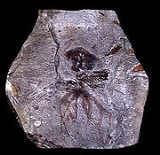
Palaeoctopus newboldi
Encyclopedia
Palaeoctopus newboldi was a primitive octopod
that lived in the Late Cretaceous
, approximately 89 to 71 million years ago. Fossil material assigned to this species originates from the Mount Hajoula region in Lebanon
. The holotype
was found below the Old Covent, Sahel-el-Alma, Mount Lebanon
and is deposited at the Natural History Museum
in London
. It might belong to the Cirrina or be more basal
in the Octopoda. Specimens from the Turonian of Mexico transpired to in fact be part of a coelocanth.
A separate species, P. pelagicus, is known from the Early Turonian of Vallecino.
Octopus
The octopus is a cephalopod mollusc of the order Octopoda. Octopuses have two eyes and four pairs of arms, and like other cephalopods they are bilaterally symmetric. An octopus has a hard beak, with its mouth at the center point of the arms...
that lived in the Late Cretaceous
Late Cretaceous
The Late Cretaceous is the younger of two epochs into which the Cretaceous period is divided in the geologic timescale. Rock strata from this epoch form the Upper Cretaceous series...
, approximately 89 to 71 million years ago. Fossil material assigned to this species originates from the Mount Hajoula region in Lebanon
Lebanon
Lebanon , officially the Republic of LebanonRepublic of Lebanon is the most common term used by Lebanese government agencies. The term Lebanese Republic, a literal translation of the official Arabic and French names that is not used in today's world. Arabic is the most common language spoken among...
. The holotype
Holotype
A holotype is a single physical example of an organism, known to have been used when the species was formally described. It is either the single such physical example or one of several such, but explicitly designated as the holotype...
was found below the Old Covent, Sahel-el-Alma, Mount Lebanon
Mount Lebanon
Mount Lebanon , as a geographic designation, is a Lebanese mountain range, averaging above 2,200 meters in height and receiving a substantial amount of precipitation, including snow, which averages around four meters deep. It extends across the whole country along about , parallel to the...
and is deposited at the Natural History Museum
Natural History Museum
The Natural History Museum is one of three large museums on Exhibition Road, South Kensington, London, England . Its main frontage is on Cromwell Road...
in London
London
London is the capital city of :England and the :United Kingdom, the largest metropolitan area in the United Kingdom, and the largest urban zone in the European Union by most measures. Located on the River Thames, London has been a major settlement for two millennia, its history going back to its...
. It might belong to the Cirrina or be more basal
Basal (phylogenetics)
In phylogenetics, a basal clade is the earliest clade to branch in a larger clade; it appears at the base of a cladogram.A basal group forms an outgroup to the rest of the clade, such as in the following example:...
in the Octopoda. Specimens from the Turonian of Mexico transpired to in fact be part of a coelocanth.
A separate species, P. pelagicus, is known from the Early Turonian of Vallecino.
See also
- Jeletzkya douglassae
- Pohlsepia mazonensisPohlsepia mazonensisPohlsepia mazonensis is the earliest described octopod, dated at approximately 296 million years old. The species is known from a single exceptionally preserved fossil discovered in the Pennyslvanian Francis Creek Shale of the Carbondale Formation, NE Illinois, USA.Pohlsepia mazonensis is named...
- Proteroctopus ribetiProteroctopus ribetiProteroctopus ribeti was a primitive octopod that lived in the Middle Jurassic, approximately 164 million years ago. The single fossil specimen assigned to this species originates from the Lower Callovian of Voulte-sur-Rhône in France. It is currently on display at the Musée de Paléontologie de La...
- Vampyronassa rhodanicaVampyronassa rhodanicaVampyronassa rhodanica is an extinct vampyromorph cephalopod known from around 20 fossils from the Lower Callovian of La Voulte-sur-Rhône, Ardèche, France....
- 2009 extinct fossil octopus discoveries

